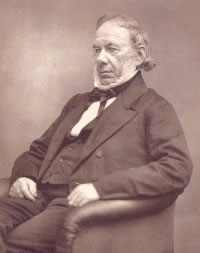John Mercer (chemist)
John Mercer (born February 21, 1791 in Great Harwood , Lancashire , † November 30, 1866 in Oakenshaw , Lancashire) was the founder of the process for textile finishing named after him, mercerization .
His father, Robert Mercer was first spinner , then hand weaver . His mother's name was Betty Clayton. At the age of nine, Mercer was already filling the heads of the shuttles for his father. He never went to school, a neighbor taught him to read and write, and a civil servant taught higher mathematics. He acquired knowledge of chemistry in self-study by studying James Parkinson's Chemical Pocket Book from 1814 . In 1809 he was an apprentice in a textile printer in Oakenshaw , but was fired for economic reasons. As a result of inventions that had taken place in the meantime, his reputation grew and he was hired as a chemist in 1818 at the textile printing works in Oakenshaw, which had previously fired him. He improved indigo dyeing, made further inventions and became a partner in 1825. When the company was dissolved in 1848, he became relatively wealthy. He was a juror at the Great Exhibition of 1851 and 1862 and was Justice of the Peace for Lancashire.
Mercer dealt with the dyeing of textiles. He invented numerous dyes and was one of the first to print photographs on fabric. The first dye he discovered was antimony sulfide , which was the first to dye cotton orange. But there was no financial gain from this.
In 1844 he invented the process named after him (mercerization) by treating cotton with caustic soda to show that this increases the absorption of color and the fabric becomes denser, stronger and more translucent. In 1851 it was patented in Great Britain and the USA . However, it did not gain acceptance until much later, when Horace Arthur Lowe realized that it could be used to create shine.
Mercer was a member of the Royal Society , the Chemical Society , the Philosophical Society .
In 1814 he married Mary Wolstenholme (died 1859), with whom he had six children.
literature
- Winfried RL Pötsch (lead), Annelore Fischer, Wolfgang Müller: Lexicon of important chemists , Harri Deutsch 1989, p. 298.
- WH Brock, PJ Hartog, Article in Dictionary of National Biography , 2004.
Web links
| personal data | |
|---|---|
| SURNAME | Mercer, John |
| BRIEF DESCRIPTION | English inventor of mercerization |
| DATE OF BIRTH | February 21, 1791 |
| PLACE OF BIRTH | Great Harwood , Lancashire |
| DATE OF DEATH | November 30, 1866 |
| Place of death | Oakenshaw , Lancashire |
